
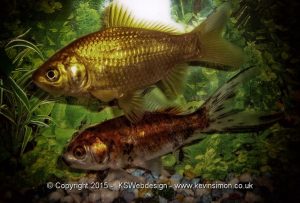
Stocking With Fish
This is the culmination of any water gardener’s endeavor. But it should be 2 – 3 weeks after planting before you introduce the first fish. Apart from ornamentation the fish performs a scavenging service, helping to keep the pool clear by controlling insect life in and around the pool. As a general guide the stocking ratio for a new pool should be 1″- 2″ of fish for every square foot of water area. Maintaining this level will ensure that conditions in the pool remain healthy. Increased stocking ratios may be feasible with the addition of a water aeration system eg. a pump and the use of a Biological Pool Filter. The aeration will help maintain adequate oxygen levels whilst the Biological Filter will help break down the build up of harmful waste products from the fish.
Overcrowding with fish will quickly result in oxygen deficiency particularly at night when plants reverse the process of adding oxygen to the water and instead consume oxygen and give off carbon dioxide. Low oxygen levels cause stress and in severe conditions will result in death.
Often fish can be found dead in the early hours of the morning showing no external symptoms. This is often a sure sign of overcrowding and lack of oxygen. Golden Orfe are particularly susceptible. In addition to oxygen deficiency overcrowding will also give rise to other stress related problems which include fungal and bacterial infections.
Care should be taken when introducing new fish to the pool. It’s best to transport the fish in cool dark conditions. Float the unopened bag on the pond surface for 15 – 30 minutes, so that the temperature of the water inside the bag may adjust to that of the pond. With the bag open and floating on the surface it is also advisable to introduce several cupfuls of pond water into the bag over a period of 10 minutes. This will help to reduce any stress caused by changes in water chemistry (ie. moving fish from hard to soft water or vice-versa and from acid to alkaline water or vice-versa).
The condition of the pond water can be checked with the aid of Test Kits.
Having carried out the above procedure the fish can be slowly released into their new environment. Fish are shy creatures so don’t be put off or worried if they disappear into the depths and hide away for the first few days. Given tine they will adapt to their new surroundings and will very quickly learn to venture up to the surface when enticed with flake or pelleted food.
There are many varieties of hardy pond fish that can be mixed safely together. These include:-
 |
GOLDFISH Extremely hardy, an ideal first fish for the new pool. Usually red/orange in colour but can have a white or black marking. Will breed readily in the garden pool once fish have reached approximately 5″ in length. |
 |
RED COMETS (SARASAS) Another variety of goldfish with distinctive long flowing fins. Colours include red and orange. Sarasa Comets have defined blood red markings on a white body. A spectacular addition to the pool. |
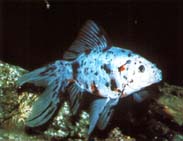 |
SHUBUNKINS Another hardy fish similar in shape to the goldfish. The fish has an array of colourful red, white and black markings on a blue/green body. Often described as the “Poor Man’s Koi”, the shubunkin is a very popular inhabitant of the garden pool. Also available in comet form with long flowing fins. |
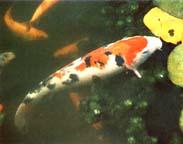 |
KOI CARP Perhaps the most beautiful and exotic of all the pond fish. Renowned for its gentle nature and ability to come and feed out of your hands. Available in a wide variety of colours often with spectacular markings. The Koi is a fast growing fish and in lakes can grow up to 3ft. in length. Often the best results with Koi are obtained when the fish are kept as an individual species in a well filtered pool |
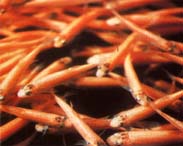 |
GOLDEN ORFE More usually golden/orange in colour, the long sleek body of the orfe makes it a fast active addition to the pool. Will spend much of its time feeding on small flies and insects at the pool surface. The orfe likes to swim in shoals and it is advisable to have not less than 3 in the pool. Care should also be taken to ensure that orfe are introduced to a well oxygenated pond. |
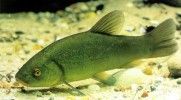 |
TENCH The green tench, commonly found n most natural slow moving waters 5 a useful addition to the pool. Often referred to as a scavenger, the fish will consume any uneaten food particles that fall to the bottom of the pool. Uneaten food if allowed to decay on the bottom will quickly start to foul the water, giving rise to infections. In addition to the green tench there is the “Golden Tencb”, less common and not always available. This fish has the added attraction of its fine golden appearance enabling you to see the fish when pool conditions are clear. In addition to the fish listed there are other varieties, subject to availability, which can become part of the community. These include:- Red/ White Fantails, Calico Fan tails, Black Moors. |
FISH COLLECTIONS
It is important to remember that when stocking a new pool the total fish collection should be acquired over a period of time in order not to upset the biological balance.
The following collections are carefully selected to contain an attractive assortment of fish for pools of various sizes. Use them as a guide to stocking your own pool. As a guide:- Small fish 1 – 2′ long, Medium fish 2 -3′ long, Large fish 4 – 5′ long.
| COLLECTION 0 For pools not less than 10 sq. ft. 10.93 sq. m.l n area. 3 small Goldfish, 3 small Shubunkins. |
COLLECTION 1 For pools not less than 15 sq. ft. (1.04 sq. in.) in area. 4 medium Goldfish, 3 medium Shubunkins. |
COLLECTION 2 For pools not less than 25 sq.ft. 12.32 sq. in.) in area. 6 medium Goldfish, 6 medium Shubunkins. |

To see more tip and articles from KS Pond Services see below or for what services KS Pond Services can supply see our section on this site HERE
[display-posts category=”pond-tips”]
